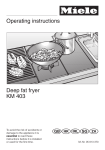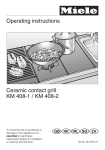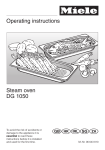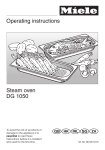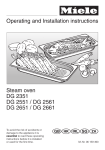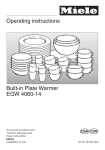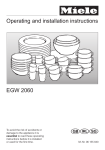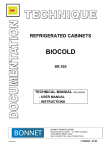Download Miele EGW 4060-14 Operating instructions
Transcript
Operating and installation instructions EGW 4050-14 / EGW 4050-29 EGW 4060-14 / EGW 4060-29 To avoid the risk of accidents or damage to the appliance it is essential to read these operating instructions before it is installed and used for the first time. GHirZ M.-Nr. 06 155 950 2 Contents Description of the appliance . . . . . . . . . . . . . . . . . . . . . . . . . . . . . . . . . . . . . . . . . 4 Warning and Safety instructions . . . . . . . . . . . . . . . . . . . . . . . . . . . . . . . . . . . . . 5 Caring for the environment . . . . . . . . . . . . . . . . . . . . . . . . . . . . . . . . . . . . . . . . . . 8 Before using for the first time . . . . . . . . . . . . . . . . . . . . . . . . . . . . . . . . . . . . . . . . 9 General notes . . . . . . . . . . . . . . . . . . . . . . . . . . . . . . . . . . . . . . . . . . . . . . . . . . . . . 9 Cleaning and heating up for the first time . . . . . . . . . . . . . . . . . . . . . . . . . . . . . . . . 9 Operation . . . . . . . . . . . . . . . . . . . . . . . . . . . . . . . . . . . . . . . . . . . . . . . . . . . . . . . 10 Controls . . . . . . . . . . . . . . . . . . . . . . . . . . . . . . . . . . . . . . . . . . . . . . . . . . . . . . . . . 10 Using the drawer . . . . . . . . . . . . . . . . . . . . . . . . . . . . . . . . . . . . . . . . . . . . . . . . . . 11 Selecting a temperature. . . . . . . . . . . . . . . . . . . . . . . . . . . . . . . . . . . . . . . . . . . . . 11 Heating up times . . . . . . . . . . . . . . . . . . . . . . . . . . . . . . . . . . . . . . . . . . . . . . . . . . 12 Capacity. . . . . . . . . . . . . . . . . . . . . . . . . . . . . . . . . . . . . . . . . . . . . . . . . . . . . . . . . 12 Cleaning and care . . . . . . . . . . . . . . . . . . . . . . . . . . . . . . . . . . . . . . . . . . . . . . . . 14 E-Cloth . . . . . . . . . . . . . . . . . . . . . . . . . . . . . . . . . . . . . . . . . . . . . . . . . . . . . . . . . . 14 Appliance front, control panel and interior . . . . . . . . . . . . . . . . . . . . . . . . . . . . . . 14 Anti-slip mat . . . . . . . . . . . . . . . . . . . . . . . . . . . . . . . . . . . . . . . . . . . . . . . . . . . . . . 15 Problem solving guide. . . . . . . . . . . . . . . . . . . . . . . . . . . . . . . . . . . . . . . . . . . . . 16 After sales service, data plate. . . . . . . . . . . . . . . . . . . . . . . . . . . . . . . . . . . . . . . 17 Installation . . . . . . . . . . . . . . . . . . . . . . . . . . . . . . . . . . . . . . . . . . . . . . . . . . . . . . 18 Safety instructions for installation . . . . . . . . . . . . . . . . . . . . . . . . . . . . . . . . . . . . . 18 Niche dimensions . . . . . . . . . . . . . . . . . . . . . . . . . . . . . . . . . . . . . . . . . . . . . . . . . 18 Possible installation examples for EGW 40x0 - 14 . . . . . . . . . . . . . . . . . . . . . . . . 19 Possible installation examples for EGW 40x0 -29 . . . . . . . . . . . . . . . . . . . . . . . . . 22 Positioning the appliance in the housing unit . . . . . . . . . . . . . . . . . . . . . . . . . . . . 24 Aligning the front of the plate warmer . . . . . . . . . . . . . . . . . . . . . . . . . . . . . . . . . . 25 Electrical connection . . . . . . . . . . . . . . . . . . . . . . . . . . . . . . . . . . . . . . . . . . . . . . . 26 3 Description of the appliance a On/Off switch (lights up) b Temperature control c Warming drawer d Non-slip mat e In-operation indicator 4 Warning and Safety instructions To avoid the risk of accidents to the appliance please read these instructions carefully before using it for the first time. They contain important information on its installation, safety, use and maintenance. The use of the appliance by the elderly or infirm or those who have not used the appliance before should be supervised by a competent and responsible person to avoid the risk of injury. Please stick the extra data plate for the appliance supplied with this documentation in the space provided in the "After sales service" section of this booklet. Keep these instructions in a safe place and pass them on to any future user. Technical safety Before connecting the appliance to the mains supply make sure that the voltage and frequency correspond to the rating on the data plate. This data must correspond in order to avoid the risk of damage to the appliance. Consult a qualified electrician if in any doubt. This appliance should be connected via a double pole fused spur connection unit or a fused plug and switched socket. If you wish to connect it to an isolator switch, or if the appliance is supplied without a plug, it must be installed and connected by a suitably qualified and competent person in strict accordance with local and national safety regulations. The manufacturer cannot be held liable for damage caused by incorrect installation or connection. The electrical safety of this appliance can only be guaranteed when continuity is complete between the appliance and an effective earthing system which complies with local and national safety regulations. It is most important that this basic safety requirement is present and regularly tested, and where there is any doubt the electrical system in the house is checked by a qualified electrician. The manufacturer cannot be held liable for the consequences of an inadequate earthing system (e.g. electric shock). Do not connect the appliance to the mains electrical supply by an extension lead. Extension leads do not guarantee the required safety of the appliance (e.g. danger of overheating). For safety reasons the drawer must only be used after it has been built in. This is necessary to ensure that all electrical components are shielded. 5 Warning and Safety instructions Never open the casing of the appliance. Tampering with electrical connections or components is highly dangerous to the user and can cause operational faults. Installation work, maintenance and repairs may only be carried out by suitably qualified and competent persons in accordance with national and local safety regulations to ensure safety. Repairs and other work by unqualified persons could be dangerous and the manufacturer will not be held liable. While the appliance is under guarantee, repairs should only be undertaken by a service engineer authorised by the manufacturer. Otherwise the guarantee is invalidated. During installation, maintenance and repair work, the appliance must be disconnected from the mains electricity supply. The appliance is only completely isolated from the electricity supply when: – the mains fuse is withdrawn, – or the screw-out fuse is removed (in countries where this is applicable), – or it is switched off at the isolator or at the wall socket and the plug removed. Ensure that current is not supplied to the appliance until after maintenance or repair work has been carried out. 6 Correct usage This appliance complies with all relevant legal safety requirements. Incorrect use can lead to personal injury and damage to property. This appliance is intended for domestic use only to warm plates, dishes and other crockery. Any other usage is not supported by the manufacturer and could be dangerous. The manufacturer cannot be held liable for damage caused by incorrect or improper use of the appliance. Depending on the temperature selected and the length of time the appliance is being used, the inside of the drawer can get as hot as 80 °C. To avoid burning or scalding yourself, always use protective oven gloves to remove plates and dishes from the drawer. A child's skin burns more easily than an adult's. Keep children away from the appliance, and do not allow them to play with it or near it. Switching the appliance on inadvertently causes it to heat up, with a danger of burning. Warning and Safety instructions This appliance is not a toy! Do not let children access the drawer or its controls. Supervise its use by the elderly or infirm. Do not use the appliance to heat up the room. Due to the high temperatures radiated, objects near the appliance could catch fire. Do not use the appliance to re-heat, cook or keep food or drinks warm, as moisture in the food or drinks could cause corrosion damage to the drawer. Do not use a steam cleaner to clean this appliance. The steam could reach electrical components and cause a short circuit. Pressurised steam could also cause permanent damage to the surface and to other components, for which the manufacturer cannot accept liability. Do not sit or lean on the opened drawer. This can damage the telescopic runners. The drawer has a maximum load bearing capacity of 25 kg. Do not store any plastic containers, houseold foil and wraps, or any inflammable objects in the warming drawer. They could melt or catch fire when the appliance is switched on. 7 Caring for the environment Disposal of the packing material The transport and protective packing has been selected from materials which are environmentally friendly for disposal and can normally be recycled. Packaging, e.g. cling film, polystyrene and plastic wrappings, must be kept out of the reach of babies and young children. Danger of suffocation. Disposal of your old appliance Electrical and electronic appliances often contain materials which, if handled or disposed of incorrectly, could be potentially hazardous to human health and to the environment. They are, however, essential for the correct functioning of your appliance. Please do not therefore dispose of it with your household waste. Dispose of or recycle all packaging materials safely as soon as possible. Contact your local waste collection centre for details of available recycling schemes. Please dispose of it at your local community waste collection/recycling centre, and ensure that it presents no danger to children while being stored for disposal. It should be unplugged or disconnected from the mains electricity supply by a competent person. If connected by a plug, the plug must be rendered useless and the cable cut off directly behind the appliance to prevent misuse. 8 Before using for the first time General notes The plate warmer is intended exclusively for heating crockery. It uses a hot air warming system. A fan distributes heat given off by a heater element evenly throughout the drawer. The circulating air ensures that crockery is heated evenly and quickly. A protective grille protects you from touching either the fan or the heating elements. The base of the drawer is fitted with a non-slip mat which stops crockery sliding about when the drawer is opened and closed. Cleaning and heating up for the first time Before using for the first time proceed as follows: ^ Wipe the appliance with a damp cloth only, and then dry with a soft cloth. ^ Then heat the empty drawer for at least two hours. Set the temperature control to maximum (see "Selecting a temperature"). It is important to ensure that the room is well ventilated. Metal components have a protective coating which may give off a slight smell when heated up for the first time. The smell and any vapours will dissipate after a short time and do not indicate a faulty connection or appliance defect. 9 Operation Controls Do not use the appliance to re-heat, cook or keep food or drinks warm. Condensation from the food or drinks could lead to corrosion in the appliance. Always use heat-resistant gloves to remove heated crockery from the drawer. The load bearing capacity of the appliance, irrespective of its height, is 25 kg maximum. The controls consist of a temperature dial and an On/Off switch. These are only visible when the drawer is open. When the drawer is closed, you can tell when the appliance is switched on because the On/Off switch illuminates through the hole in the front of the drawer. 10 Operation Using the drawer Selecting a temperature ^ Place crockery inside the drawer. The temperature dial allows you to select any temperature between approx. 30 and 80 °C. ^ Select the temperature required. ^ Switch on the appliance (j). The switch lights up. ^ Close the drawer gently: if you use too much force, it can spring open again. ^ Switch the appliance off (k) before removing the heated crockery. The temperature dial must only be turned in a clockwise direction as far as it will go and then back again. Do not turn it too far as this will damage it. When the temperature is reached, the heating element switches itself off. When the temperature falls below that selected, the heating element switches on again automatically. The temperature scale around the dial is shown in symbols rather than in °C. The symbols represent the most suitable temperature for the type of crockery depicted: – b approx. 40 °C for cups or glasses. Drinks poured into warmed cups do not cool down so quickly. At the same time, the cups will not get too hot to handle. – r approx. 60 °C for serving dishes and plates. Food stays warm for longer if served in pre-heated dishes. The dishes will not get too hot to handle. 11 Operation Heating up times Capacity Various factors will affect the heating up times: There a two different plate warming drawers which differ in height: – the material and thickness of the crockery – EGW 40x0 - 14: 141 mm high. – the quantity – how the crockery is arranged – the temperature setting. It is therefore not possible to state precise times. However, the following information can be used as a guide: Temperature setting r is approx. 60 °C. Evenly heated crockery will take about: – 30 - 35 minutes for 6 place settings. – 40 - 45 minutes for 12 place settings. As you use the plate warmer, you will get to know which setting suits your own needs best. 12 – EGW 40x0 - 29: 289 mm high. The quantity that can be loaded will depend to a great extent on the type and size of your own crockery. The maximum load bearing capacity of the drawer is 25 kg. The layouts shown here are suggestions only. Operation EGW 4050 - 14 / EGW 4060 - 14 EGW 4050 - 29 / EGW 4060 - 29 – 6 place settings: 6 dinner plates 6 soup bowls 1 serving dish 1 serving dish 1 serving dish 2 meat platters – 12 place settings: 12 dinner plates 2 serving dishes 2 serving dishes 2 serving dishes 2 meat platters C C C C C 28 cm 10 cm 22 cm 19 cm 17 cm 36 cm C C C C 28 cm 22 cm 19 cm 17 cm 36 cm or or – 20 dinner plates C 28 cm – 40 dinner plates C 28 cm – 36 soup bowls C 22 cm – 60 soup bowls C 22 cm – 30 soup bowls C 10 cm – 45 soup bowls C 10 cm – 20 dinner plates 20 soup bowl C 28 cm C 22 cm – 20 pizza plates C 36 cm – 10 dinner plates C 28 cm 10 soup bowls C 22 cm – 10 pizza plates C 36 cm – 80 espresso cups – 120 espresso cups – 40 cappuccino cups – 60 cappuccino cups – 30 punch glasses – 30 punch glasses – 18 soup bowls 2 soup terrines C 22 cm 21 cm x18 cm – ... – ... – ... – ... 13 Cleaning and care E-Cloth – sharp metal tools, A microfibre “E-Cloth” is available from the Miele UK Spare Parts Department, which is suitable for cleaning surfaces such as stainless steel, glass, plastic and chrome without the use of chemicals. It can be washed 300 times. – oven sprays. Appliance front, control panel and interior Allow the appliance to cool down to a safe temperature before cleaning. Aluminium fronts Aluminium is affected by the way that light falls on it, by the surrounding environment and by the angle you observe it from. Aluminium surfaces may suffer discolouration or damage if soiling is left on them for too long. Remove any soiling straight away. ^ All surfaces and controls should be cleaned using a Miele E-Cloth or with warm water and a little washing up liquid applied with a soft sponge or cloth. The appliance front is susceptible to scratches and abrasions. ^ Wipe the surfaces dry using a soft cloth. – cleaning agents containing soda, acids or chlorides, To prevent the risk of scratches and damage to the surface structure, pay particular attention to the following cleaning instructions for glass or metal fronted appliances. Glass fronts The appliance front and controls are susceptible to scratches and abrasions. Do not use: – abrasive cleaning agents, e.g. powder cleaners and cream cleaners. – abrasive sponges, e.g. pot scourers or sponges which have been previously used with abrasive cleaning agents, 14 Do not use: – abrasive cleaning agents, e.g. powder cleaners and cream cleaners, – abrasive sponges, e.g. pot scourers or sponges which have been previously used with abrasive cleaning agents, – stainless steel cleaning agents, – cleaning agents containing descaling agents, – dishwasher cleaner, – oven sprays. Cleaning and care Titanium finish fronts Titanium surfaces have a velvety finish which does not show fingerprints. Clean as you would glass or porcelain. The appliance front is susceptible to scratches and abrasions. Do not use: – abrasive cleaning agents, e.g. powder cleaners and cream cleaners. – abrasive sponges, e.g. pot scourers or sponges which have been previously used with abrasive cleaning agents, – sharp metal tools, – oven sprays. – abrasive sponges, e.g. pot scourers or sponges which have been previously used with abrasive cleaning agents. To help prevent re-soiling, a conditioning agent for stainless steel, such as Neoblank (available from the Miele Spare Parts Department), can also be used. Follow the manufacturer's instructions. Anti-slip mat The anti-slip mat can be removed from the drawer for cleaning. The mat is best cleaned by hand using warm water with a little washing-up liquid. Dry it thoroughly. Do not put the anti-slip mat back into the drawer until it is completely dry. Stainless steel fronts The appliance front is susceptible to scratches and abrasions. Never dry the anti-slip mat in the oven. Fire hazard. Stainless steel surfaces can be cleaned using a Miele E-Cloth or with a proprietary non-abrasive cleaning agent designed specifically for use on stainless steel. N.B. Do not use stainless steel cleaning agents on the controls. Do not use: – cleaning agents containing soda, acids or chlorides, – abrasive cleaning agents, e.g. powder cleaners and cream cleaners, 15 Problem solving guide Installation work and repairs to electrical components of this appliance must only be carried out by a suitably qualified and competent person in accordance with local and national safety regulations. Repairs and other work by unqualified persons could be dangerous. The manufacturer cannot be held liable for unauthorised work. What to do if . . . . . . the crockery is not warm enough. Check whether, If any of the following problems occur, the advice of a qualified electrican or the Service Department must be sought. . . . the crockery does not heat up. Check whether, – you can hear the fan. If you can hear the fan: There is a problem with the heater element. If you cannot hear the fan: There is a problem with the fan. – the mains fuse has blown. – the appliance has been switched on. – the correct temperature setting has been selected. . . . The crockery is too hot. The temperature control is faulty. – Any ventilation openings have been blocked by large plates or bowls. – the crockery has been allowed to heat up for a sufficiently long time. Various factors will affect how long the crockery will take to heat up, for example: – the material and thickness of the crockery – the quantity – how the crockery is arranged – the temperature setting The times quoted are only guidelines. As you use the plate warmer you will get to know which setting suits your own needs best. 16 . . . the On/Off switch does not light up when the appliance is switched on. The indicator light for the switch is defective. After sales service, data plate In the event of any faults which you cannot remedy yourself, or if the appliance is under guarantee, please contact: – Your Miele dealer, or – the Miele Service Department (see address on back cover). When contacting the Service Department, please quote the model and serial number of your appliance, which are given on the data plate. Please note that telephone calls may be monitored and recorded for training purposes. Space in which to stick the extra data plate supplied with the appliance. Ensure that the model number is the same as the one on the front of these instructions. 17 Installation Safety instructions for installation Before connecting the appliance to the mains supply make sure that the voltage and frequency correspond to the rating on the data plate. This data must correspond in order to avoid the risk of damage to the appliance. Consult a qualified electrician if in any doubt. The socket and on-off switch should be easily accessible after the appliance has been built in. The plate warmer may only be built in in combination with those appliances quoted by the manufacturer as being suitable. The manufacturer cannot guarantee trouble-free operation if the appliance is operated in combination with appliances other than those quoted by the manufacturer as being suitable. When building in the plate warmer in combination with another suitable appliance, the plate warmer must be fitted above a fixed interim shelf in the housing unit to ensure that the housing unit can support both its weight and that of the other appliance. As the combination appliance is placed directly on top of the plate warmer once it is built in, an interim shelf is not necessary between the two appliances. 18 When building in the combination appliance, it is essential to follow the instructions given in the operating and installation instructions supplied with it. This equipment may only be used in mobile installations such as ships, caravans, aircraft etc. if a risk assessment of the installation has been carried out by a suitably qualified engineer. Niche dimensions There a two different plate warming drawers which differ in height. The building-in dimensions for the plate warmer must be added to the building-in dimensions for the combination appliance to establish the niche size required. All dimensions in this instruction booklet are given in mm. Installation Possible installation examples for EGW 40x0 - 14 Microwave-combi ovens Oven series H 310, H 4120, H 4220 and above 19 Installation Steam oven Combi steam oven a 30 522 549 05 22 455,5 8 -56 560 446 593-595 55 141 128 5 59 6 7 53 5 59 54 8 22 7 a Cut-out for ventilation of the combi steam oven 20 Installation Coffee machine 21 Installation Possible installation examples for EGW 40x0 -29 Oven series H 310, H 4120, H 4220 and above 22 Steam oven Installation Combi steam oven a Coffee machine 30 522 549 55 455,5 0 22 5 59 286 8 -56 560 446 741-743 5 7 289 53 2 5 54 59 8 22 1 a Cut-out for ventilation of the combi steam oven 23 Installation Positioning the appliance in the housing unit ^ Push the appliance into the housing unit as far as the vapour strip and align it. The appliance is supplied with three metal trims which have an adhesive underside. These trims must be stuck on to the drawer so that they seal any gaps between the housing unit and the appliance. Any air gap created acts as additional insulation and helps prevent heat-loss. ^ Carefully pull the protective foil off the underside of each trim. ^ Then position the trim as shown in the illustration so that they are flush with the side walls and the back wall of the housing unit and then stick them to the plate warmer. If the unit does not have a back wall you do not need the third trim. Ensure that the housing unit is aligned at a right angle. ^ Open the drawer, and use the 2 screws supplied to secure the appliance to the side walls of the housing unit. 24 ^ Build in the combination appliance in accordance with its operating and installation instructions. Installation Aligning the front of the plate warmer After building in the combination appliance, it may be necessary under certain circumstances to – align the front of the plate warmer – align the gap between the plate warmer and the combination appliance. To help you do this, there are adjusting points underneath the nuts which secure the drawer to the telescopic runners. ^ Loosen the nuts and take the plate warmer drawer out. Use the adjusters to – raise or lower the drawer – align the front of the drawer. 25 Installation Electrical connection All electrical work should be carried out by a suitably qualified and competent person, in strict accordance with current national and local safety regulations (BS 7671 in the UK). Installation, repairs and other work by unqualified persons could be dangerous. The manufacturer cannot be held liable for unauthorised work. Ensure power is not supplied to the appliance until after installation work has been carried out. The appliance must only be operated when built-in. This is to ensure that all electrical parts are shielded. Live parts must not be exposed. Do not connect the appliance to the mains electricity supply via an extension lead. These do not guarantee the required safety of the appliance. Please ensure that the connection data quoted on the data plate match the household mains supply. Connection should be made via a double pole fused spur connection unit or fused plug and switched socket which complies with national and local safety regulations and the on/off switch should be easily accessible after the appliance has been built in. If the switch is not accessible after installation (depending on country) an additional means of disconnection must be provided for all poles. For extra safety it is advisable to install a residual current device (RCD), with a trip current of 30 mA. When switched off there must be an all-pole contact gap of 3 mm in the isolator switch (including switch, fuses and relays). Important U.K. This appliance is supplied for connection to a single phase 230-240 V 50 Hz supply with a 3-core cable. The wires in the mains lead are coloured in accordance with the following code: Green/yellow = earth Blue = neutral Brown = live WARNING: THIS APPLIANCE MUST BE EARTHED 26 Installation Non-rewireable plugs BS 1363 Important The fuse cover must be refitted when changing the fuse, and if the fuse cover is lost, the plug must not be used until a suitable replacement is obtained. The colour of the correct replacement cover is that of the coloured insert in the base of the plug, or the colour that is embossed in words on the base of the plug (as applicable to the design of plug fitted). The electrical safety of this appliance can only be guaranteed when continuity is complete between the appliance and an effective earthing system, which complies with local and national regulations. It is most important that this basic safety requirement is tested regularly and where there is any doubt the household wiring should be inspected by a qualified electrician. The manufacturer cannot be held liable for the consequences of an inadequate earthing system such as electric shock. Replacement fuses should be ASTA approved to BS 1362 and have the correct rating. Replacement fuses and fuse covers may be purchased from your local electrical supplier. The manufacturer cannot be held liable for damage which is the direct or indirect result of incorrect installation or connection. 27 Alteration rights reserved / 4306 M.-Nr. 06 155 950 / 02 en - GB




























